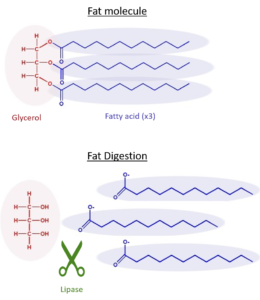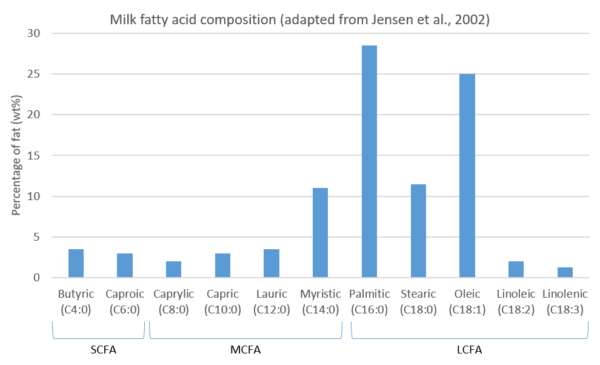Why add butyrate to milk replacer?
 Young ruminants rely heavily on milk in the early stages of life to provide proteins, energy and essential nutrients to grow and stay healthy. The energy from milk comes from milk sugars (lactose) and fat. Fats are molecules that consist of 3 fatty acids on a glycerol backbone. When an animal digests fat it will enzymatically separate the fatty acids from the glycerol backbone. The length and structure of the fatty acid determine largely the digestibility and functionality of these fatty acids. Fatty acid composition is therefore an important point of attention when formulating milk replacers to ensure proper digestion and to provide essential fatty acids. There are 3 main categories of fatty acids: Short Chain (SCFA), Medium Chain (MCFA) and Long Chain (LCFA).
Young ruminants rely heavily on milk in the early stages of life to provide proteins, energy and essential nutrients to grow and stay healthy. The energy from milk comes from milk sugars (lactose) and fat. Fats are molecules that consist of 3 fatty acids on a glycerol backbone. When an animal digests fat it will enzymatically separate the fatty acids from the glycerol backbone. The length and structure of the fatty acid determine largely the digestibility and functionality of these fatty acids. Fatty acid composition is therefore an important point of attention when formulating milk replacers to ensure proper digestion and to provide essential fatty acids. There are 3 main categories of fatty acids: Short Chain (SCFA), Medium Chain (MCFA) and Long Chain (LCFA).
Maximizing the fatty acid profile
Cow’s milk naturally contains a balanced fatty acid profile with all 3 categories of fatty acids represented. LCFA can be provided via lard or palm oil, MCFA via coconut oil, but SCFA’s are typically found in butter fat. To get as close to the fatty acid profile of milk as possible, butyric acid (via sodium butyrate) has been incorporated into calf feed, however, can potentially have an odour. To get the benefits of an SCFA without odour, we have encapsulated the tributyrin inside the fat in our milk replacers! Tributyrin is another form of butyric acid consisting of 3 butyric acid molecules attached to the glycerol backbone.

Increased digestibility
Young calves (< 3 weeks) have limited enzymatic capabilities in their small intestine to digest nutrients because the pancreas is still developing. For fat digestion, they rely on pre-gastric lipase in these early stages of life to digest the fat (Nelson et al., 1977). Pre-gastric lipase has a preference for SCFA and MCFA which results in high digestibility of butyric acid in young calves (Villeneuve, 1996; Górka et al., 2018). LCFAs are still important nutrients because they also provide poly-unsaturated essential fatty acids like omega 3 and omega 6 fatty acids. LCFAs are also a source of structural fatty acids used for cell membranes, slow-release energy, and energy storage in adipose tissue.
Supporting health and gut development
In addition to easy digestion, butyric acid also has additional functionalities (Bedford & Gong, 2018). Butyric acid is an instant energy source for the cells lining the gastrointestinal tract (GIT). The cells can absorb the butyric acid directly from the lumen of the gut and use it as fuel. Butyric acid has also shown anti-microbial activity against Salmonella typhimurium and Clostridium perfringens for example, which might help in supporting a healthy gut microbiome. When butyric acid is absorbed from the GIT it has also been shown to elicit anti-inflammatory activities by inhibiting inflammation pathways and signalling supporting gut health and normal immune function. Lastly butyric acid is a known regulator of gene expression which can result in the stimulation of cell proliferation and therefore support gut development.
Increasing performance
Trials with butyric acid supplementation in milk replacers show promising effects by stimulating small intestine and pancreas development and function (Górka et al., 2018; Bedford & Gong, 2017; Niwinska et al., 2017). In one study, calves were supplemented with 0.3% butyric acid in the milk replacer and higher brush border lactase (the enzyme needed to digest lactose) activity was observed as well as higher maltase (the enzyme needed for starch digestion) activity (Gòrka et al., 2014). In addition, enzyme activity related to protein digestion tended to be increased when butyric acid was supplemented via the milk replacer. Furthermore, greater pancreatic juice secretion, chymotrypsin and lipase secretion were measured when the milk replacer was supplemented with butyric acid (Guilloteau et al., 2010). These studies show that butyric acid supports digestive capabilities by stimulating pancreatic and brush border enzyme secretion and activity. In another study (Hill et al., 2016) it was proven that providing a blend of butyric acid and other functional fatty acids via the milk replacer can improve digestibility. As a result, calves grew 13% more in the pre-and postweaning periods.
The addition of Tributyrin in Denkamilk milk replacers will further maximize the fatty acid profile and help to support a healthy gut, normal immune function and performance of young calves.
Click here to learn more about our milk replacers that contain tributyrin
Sources
Nelson, J. H., Jensen, R. G., & Pitas, R. E. (1977). Pregastric esterase and other oral lipases—a review. Journal of Dairy Science, 60(3), 327-362.
Villeneuve, P., Pina, M., & Graille, J. (1996). Determination of pregastric lipase specificity in young ruminants. Chemistry and physics of lipids, 83(2), 161-168.
Górka, P., Kowalski, Z. M., Zabielski, R., & Guilloteau, P. (2018). Invited review: Use of butyrate to promote gastrointestinal tract development in calves. Journal of dairy science, 101(6), 4785-4800.
Bedford, A., & Gong, J. (2018). Implications of butyrate and its derivatives for gut health and animal production. Animal Nutrition, 4(2), 151-159.
Niwińska, B., Hanczakowska, E., Arciszewski, M. B., & Klebaniuk, R. (2017). Exogenous butyrate: implications for the functional development of ruminal epithelium and calf performance. Animal, 11(9), 1522-1530.
Guilloteau, P., G. Savary, Y. Jaguelin-Peyrault, V. Rome, L. Le Normand, and R. Zabielski. 2010b. Dietary sodium butyrate supplementation increases digestibility and pancreatic secretion in young milk-fed calves. J. Dairy Sci. 93:5842–5850
Górka, P., P. Pietrzak, A. Kotunia, R. Zabielski, and Z. M. Kowalski. 2014. Effect of method of delivery of sodium butyrate on the maturation of the small intestine. J. Dairy Sci. 97:1026–1035
Hill, T. M., J. D. Quigley, F. X. Suarez-Mena, H. G. Bateman II, and R. L. Schlotterbeck. 2016. Effect of milk replacer feeding rate and functional fatty acids on dairy calf performance and digestion of nutrients. J. Dairy Sci. 99:6352–6361









